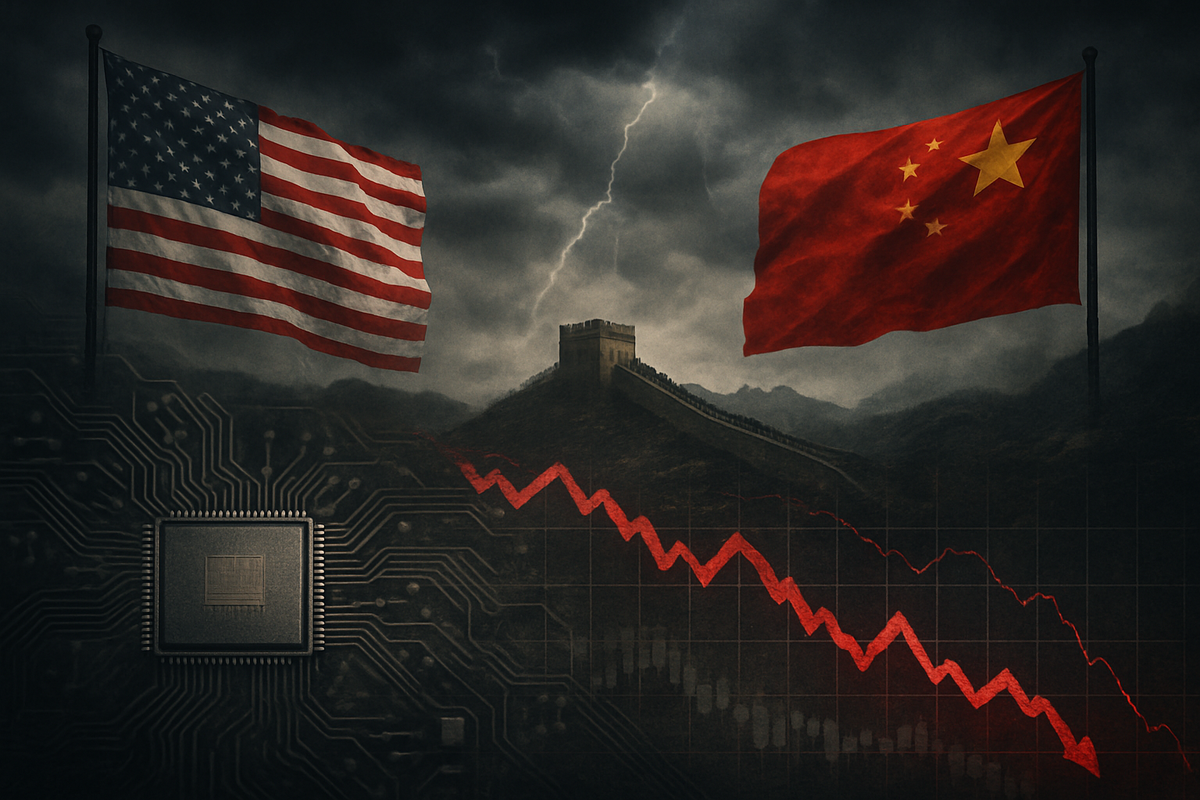
New York, NY – October 10, 2025 – The financial markets experienced a significant downturn today, with a broad market sell-off triggered by renewed and escalating US-China tariff threats. Among the hardest hit was Advanced Micro Devices (NASDAQ: AMD), whose stock tumbled as investors reacted to the potential for severe disruptions to its crucial Chinese market and global supply chains. The day's events underscore the persistent and unpredictable nature of geopolitical tensions on the technology sector.
Today's market jitters were primarily fueled by President Trump's reiteration of threats for a "massive increase" in tariffs on Chinese products, directly following China's tightened export controls on rare earth materials. Simultaneously, a bipartisan US Senate bill passed on this very day, mandating that chipmakers prioritize American customers for AI chip supply before fulfilling orders for China, a move specifically targeting industry giants like AMD and Nvidia (NASDAQ: NVDA). This confluence of events has sent a clear signal of intensifying economic nationalism, forcing companies like AMD to re-evaluate their strategic outlook.
Escalating Trade Tensions Cast a Long Shadow Over Tech
The current climate of trade hostilities is not new, but the events of October 10, 2025, mark a significant escalation. The US has been progressively tightening export controls on advanced computing and semiconductor manufacturing items since October 2022, with further expansions throughout 2023 and 2024, all aimed at restricting China's access to cutting-edge chips and AI capabilities. These actions were met with China's retaliatory measures, including restricting exports of critical materials like gallium and germanium in September 2024, culminating in an outright ban on certain exports by December 2024.
Earlier this year, in May 2025, a temporary 90-day reduction in bilateral tariffs offered a glimmer of hope for de-escalation, an agreement that was extended through November 10, 2025. However, today's pronouncements from the US leadership suggest this fragile détente is on the brink of collapse. Adding to the complexity, August 2025 saw an unprecedented development where Nvidia and AMD reportedly agreed to pay 15% of their revenues from Chinese AI chip sales to the US government to secure export licenses – a unique arrangement that directly impacts profitability.
The immediate market reaction was stark. Tech and semiconductor stocks led the broader market sell-off, with AMD's stock experiencing a notable decline of approximately 6% by the closing bell. This reflects deep investor anxiety over the ongoing trade tensions, which are now not just about tariffs but also about direct control over market access and supply prioritization. The legislative actions and executive threats signal a profound shift in market sentiment, moving away from global integration towards strategic decoupling.
Companies Impacted: AMD and Competitors Face Significant Headwinds and Strategic Shifts
Advanced Micro Devices (NASDAQ: AMD) finds itself directly in the crosshairs of this escalating trade war. The company has already incurred an $800 million charge due to a halted shipment of AI chips to China, a direct consequence of tightened US restrictions. Furthermore, AMD has been forced to write down inventory, cancel purchases, and remove China from its revenue projections, estimating a substantial revenue hit of $1.5 billion to $1.8 billion for 2025. The recent US Senate bill passed today, explicitly limiting Nvidia and AMD's AI chip exports to China, will only exacerbate these financial pressures.
AMD's product strategy is also undergoing a forced reorientation. While its MI308 accelerator was designed with export compliance in mind, its license application remains in progress, potentially taking several quarters for approval. Consequently, AMD is heavily shifting its AI strategy to focus on its MI350 chip, which entered volume production earlier in 2025, hoping it can navigate the complex regulatory landscape. The 15% revenue-sharing mandate for approved AI chip sales in China will also directly influence how AMD prices its MI-series export products, potentially impacting their competitiveness against domestic alternatives like Huawei Ascend.
Nvidia (NASDAQ: NVDA), another key player in the AI chip market, faces similar challenges with export restrictions and the revenue-sharing agreement. While US-based semiconductor firms grapple with market access issues, Chinese technology companies, such as Huawei, may see an accelerated path to self-reliance. China's "Made in China 2025" initiative and a $47.5 billion investment fund for domestic semiconductor development, launched in May 2024, underscore its determination to reduce reliance on foreign technology, potentially creating a protected market for local champions.
Wider Significance: A New Era of Geopolitical Engineering in the Semiconductor Industry
The current US-China trade tensions are accelerating a technological decoupling that profoundly reshapes the global semiconductor industry. This isn't just about tariffs; it's about a fundamental shift in how technology is developed, manufactured, and deployed. Global supply chains, once optimized for efficiency and cost, are now being re-evaluated for resilience and national security, leading to increased costs and operational uncertainties for firms across consumer electronics, automotive, and, critically, semiconductors.
The highly specialized and globally distributed nature of the semiconductor supply chain makes it uniquely vulnerable. The ongoing conflict is forcing companies to "engineer around policy, not just physics," making export compliance a primary design constraint. This policy-driven engineering adds layers of complexity and cost to product development and market strategy. Furthermore, China's dominance in rare earth elements, crucial for semiconductor manufacturing, creates potential bottlenecks and geopolitical leverage, as demonstrated by its recent export restrictions.
Historically, trade disputes have often been resolved through negotiation and compromise. However, the current standoff appears more entrenched, driven by strategic competition for technological supremacy. The risk of overbroad US restrictions inadvertently accelerating China's technological independence is a significant concern, potentially making the controls counterproductive in the long run. The global reliance on Taiwan, a key player in advanced logic chip fabrication, further exposes the industry to significant geopolitical risks and potential disruptions, amplifying the need for diversified supply chains.
What Comes Next: Adaptation, Innovation, and Persistent Uncertainty
In the short term, market volatility is expected to persist as investors react to every twist and turn in the US-China trade narrative. For AMD, navigating the complex web of export license applications and successfully ramping up its MI350 chip production will be critical. The company will need to demonstrate its ability to adapt its product roadmap and sales strategy to the new geopolitical realities, potentially shifting focus to non-restricted markets or developing compliant versions of its advanced chips.
Looking long-term, the semiconductor industry is likely heading towards further regionalization and diversification of supply chains. Companies may explore "friend-shoring" or investing heavily in domestic manufacturing capabilities to mitigate geopolitical risks. This could present opportunities for countries and regions actively seeking to attract semiconductor fabrication plants, though the costs associated with such endeavors are substantial. The ongoing push for technological self-sufficiency in China will continue, fostering innovation within its borders but potentially fragmenting global technology standards.
Investors should prepare for a market environment where geopolitical considerations often outweigh traditional economic fundamentals. Companies like AMD will need to exhibit strategic agility, not just in technological innovation but also in navigating complex international relations. Potential scenarios range from a continued tit-for-tat escalation, leading to further market fragmentation, to eventual diplomatic resolutions that could redefine the terms of trade. What remains clear is that the era of unfettered globalization for the semiconductor industry is giving way to a more constrained and strategically driven landscape.
Wrap-Up: A Pivotal Moment for Global Tech and Investment
Today's market sell-off, driven by renewed US-China tariff threats and targeted legislative action, serves as a stark reminder of the profound impact of geopolitics on the financial markets, particularly the technology sector. Advanced Micro Devices (NASDAQ: AMD) stands as a prime example of a company directly and significantly affected, facing substantial revenue hits, strategic reorientations, and the daunting challenge of "engineering around policy."
Moving forward, the market will remain highly sensitive to any developments in US-China relations. Investors should closely monitor policy announcements from both governments, AMD's progress in securing export licenses and ramping up new products, and any further retaliatory measures from China. The broader implications for global supply chains, the acceleration of technological decoupling, and the push for national self-reliance in critical technologies will define the investment landscape for years to come. The ability of companies to adapt to this new, more fractured global order will be paramount to their long-term success.
This content is intended for informational purposes only and is not financial advice





